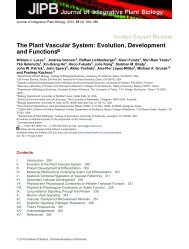New species of Solanum and Capsicum (Solanaceae) from Bolivia ...
New species of Solanum and Capsicum (Solanaceae) from Bolivia ...
New species of Solanum and Capsicum (Solanaceae) from Bolivia ...
Create successful ePaper yourself
Turn your PDF publications into a flip-book with our unique Google optimized e-Paper software.
2006] nee et al.: solanum <strong>and</strong> capsicum (solanaceae) 339<br />
Thomas Morong’s collections <strong>from</strong><br />
Paraguay <strong>and</strong> preserved at NY are generally<br />
good <strong>and</strong> with copious notes. Morong 1007,<br />
however, was a decidedly mixed collection,<br />
with at least three different <strong>species</strong> in two<br />
families represented among the various duplicates.<br />
Morong collected the plants in May<br />
(the dry season) <strong>and</strong> said in the original description<br />
that the plants “had a parched, dried<br />
appearance” (Morong & Britton, 1893). It is<br />
thus underst<strong>and</strong>able that Morong would collect<br />
specimens <strong>of</strong> one <strong>species</strong> in flower <strong>and</strong><br />
fruit (<strong>Solanum</strong> aridum) <strong>and</strong> a related <strong>species</strong><br />
mostly without leaves <strong>and</strong> in fruit (<strong>Solanum</strong><br />
multispinum N. E. Br.), although the addition<br />
<strong>of</strong> the flowering specimen <strong>of</strong> Turnera (Turneraceae)<br />
is less explicable.<br />
<strong>Solanum</strong> aridum was lectotypified by C. V.<br />
Morton (1976) on the leafy <strong>and</strong> flowering<br />
part <strong>of</strong> the duplicate US 48029, although<br />
Recommendation 9A.3 <strong>of</strong> the Code (Greuter<br />
et al., 2000) would have recommended lectotypification<br />
on the specimen NY 139054,<br />
which is labelled “type” (Fig. 7). Morong<br />
was curator <strong>of</strong> the Columbia University<br />
Herbarium (Britton, 1894), <strong>and</strong> this herbarium<br />
subsequently became the basis <strong>of</strong> the<br />
newly formed <strong>New</strong> York Botanical Garden<br />
herbarium (NY). Morton claimed that his<br />
lectotypification was somewhat “arbitrary,”<br />
but fortunately it was based on the predominant<br />
element <strong>of</strong> Morong 1007, <strong>and</strong> that which<br />
provides the major portion <strong>of</strong> the original description.<br />
The full range <strong>of</strong> duplicates with their extraneous<br />
elements can be explained as follows.<br />
The lectotype sheet <strong>of</strong> <strong>Solanum</strong><br />
aridum, US 48029, consists <strong>of</strong> a leafy <strong>and</strong><br />
flowering portion <strong>of</strong> S. aridum, along with a<br />
very spiny plant with stipitate-gl<strong>and</strong>ular<br />
stems <strong>and</strong> with leaf blades cordate at the<br />
base. This latter element corresponds to S.<br />
multispinum, parts <strong>of</strong> which are found on<br />
other duplicates as well.<br />
The specimens BM 87516 <strong>and</strong> NY 139054<br />
are a mixture <strong>of</strong> <strong>Solanum</strong> aridum, plus leafless<br />
twigs <strong>of</strong> S. multispinum with globose<br />
fruits, which accounts for the description <strong>of</strong> a<br />
fruit 3 cm in diameter <strong>and</strong> <strong>of</strong> a long fruiting<br />
pedicel; S. aridum has an ovoid fruit 1.6–1.8<br />
× 1.3–1.7 cm, <strong>and</strong> the fruiting pedicel is 1.8–<br />
3.1 cm long, but without the bristly hairs<br />
present on S. multispinum. The specimen at E<br />
consists <strong>of</strong> two plants <strong>of</strong> S. aridum, one with<br />
leaves <strong>and</strong> the other with leaves <strong>and</strong> fruits; in<br />
addition there is a flowering plant <strong>of</strong> S. multispinum.<br />
The specimens at K, MO 2766698,<br />
<strong>and</strong> the two sheets at PH consist exclusively<br />
<strong>of</strong> S. aridum. The specimen WIS ex WELC<br />
15091 has a plant with the small, ovoid fruit<br />
<strong>of</strong> S. aridum along with a piece <strong>of</strong> Turnera <strong>of</strong><br />
the Turneraceae, which accounts for the “sulphur<br />
yellow” corolla in the original description;<br />
S. aridum has a white or pale blue<br />
corolla.<br />
In the type region only two <strong>species</strong> <strong>of</strong><br />
<strong>Solanum</strong>, S. palinacanthum Dunal <strong>and</strong> S.<br />
multispinum N. E. Br., have a fruit similar to<br />
that <strong>of</strong> the ca. 3 cm diameter fruits on Morong<br />
1007. The fruiting pedicels <strong>of</strong> S. multispinum<br />
exactly match those on the fruiting<br />
specimen <strong>of</strong> Morong 1007, while the pedicels<br />
<strong>of</strong> S. palinacanthum are curved <strong>and</strong> generally<br />
much shorter.<br />
During his preparation <strong>of</strong> a treatment <strong>of</strong><br />
<strong>Solanum</strong> <strong>of</strong> Argentina, Morton (1976) annotated<br />
many specimens with a name transferring<br />
the epithet ovalifolium <strong>of</strong> S. elaeagnifolium<br />
Cav. var. ovalifolium Kuntze to a<br />
variety <strong>of</strong> S. meloncillo Parodi, but this transfer<br />
was never published, <strong>and</strong> instead these<br />
plants were named S. conditum C. V. Morton.<br />
<strong>Solanum</strong> moxosense M. Nee, sp. nov. Type:<br />
<strong>Bolivia</strong>. Beni. Prov. Cercado: Trinidad,<br />
14°50'S, 64°55'W, 200 m, weed in the city,<br />
6 Jan 1989 (fl), M. Nee 37519 (holotype:<br />
LPB; isotypes: G, MO, NY-2 sheets,<br />
USZ). (Fig. 8)<br />
Herba repens ad nodos radicans, pilis simplicibus 2–<br />
3-cellularibus sparse pilosa, aculeis acicularibus 1.7–3.5<br />
mm longibus sparse armata. Folia alterna, ovata, 5–7.5 ×<br />
3.5–6 cm, rep<strong>and</strong>a vel non pr<strong>of</strong>unde lobata, subtus<br />
sparse stellato-tomentosa. Inflorescentia extra-axillaris,<br />
racemoso-cymosa, 4–5-florus; calyx inermis; corolla<br />
alba, lobis 6.5 × 3.5 mm; antherae lineari-angustatae, 5 ×<br />
1 mm; ovarium glabrum. Bacca oblongo-ovoidea,<br />
glabra.<br />
Herb or vine, creeping <strong>and</strong> rooting at the<br />
nodes, or some stems erect, to 20 cm tall;<br />
stems slender, to ca. 2.5 mm in diameter,<br />
nearly glabrous to sparsely pilose with<br />
simple, 2–3-celled hairs, sparsely armed with<br />
prickles 1.7–3.5 mm long, slightly reflexed,<br />
nearly straight or slightly curved. Sympodial<br />
units 2- to 3-foliate, not geminate. Leaves 5–<br />
7.5 × 3.5–6 cm, simple, more or less uniform
















